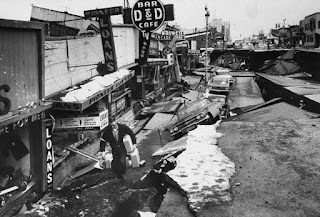 |
| Petrified trees near Girdwood, Alaska (photo by Julie Smith) |
Driving along the roadways in parts of eastern Alaska, on odd indication of the 1964 earthquake becomes apparent. The 1964 Alaska Earthquake had a profound impact on the people of Alaska and left visible scars on the land. Many of the scars and the buildings that were destroyed have long since left from view, but what remains after all these years are the tall trees that stand stark against the blue skies. They stand like soldiers guarding the memory of that terrible day in 1964 and to serve as a reminder to never underestimate the phenomenal power of nature's force. When the quake occurred, sea water came up through the fault flooding the terrain near the trees, but in the same token not uprooting them. So they not did immediately die, but the sea water caused them to turn to a petrified-state and they remain standing.
It is just one of those odd tricks and unusual quirks of nature that leaves behind an almost artistic rendering to tell the story of what took place here over 50 years ago.
 |
| Anchorage,-4th Ave.(photo:time.com/Life collections) |
Repercussions of catastrophic events such as this earthquake can have lasting, visible effects for quite some time after the clean up has been completed and people have carried on with their lives.
The 1964 Alaska earthquake had a profound impact on numerous communities along the fault line. The quake occurred on Good Friday, March 27, 1964 and according to the US Geological Survey measured 9.2 magnitude on the rector scale.
The quake was reported as the most devastating quake in North America. A total of 131 deaths were reported and the property damage totaled between 300-400 million dollars. Damage was widespread throughout the state and was felt as far as Oregon. The epicenter of the quake was about 10 km east of
the mouth of College Fiord, approximately 90 km west of Valdez and 120
km east of Anchorage. This earthquake is the second
largest earthquake ever recorded in the world. (http://www.aeic.alaska.edu/quakes/Alaska_1964_earthquake.html) Because of the epicenters location, some of the hardest hit towns were Anchorage, Valdez, Girdwood and Portage. The quake also spawned a tsunami, which contributed to the severe damage to the harbor town of Valdez. Half the town tumbled into the harbor and the disaster claimed 31 lives. Valdez was not totally destroyed but relocated 4 miles west of the original site. Traveling through Valdez today, there are signs designating "Old Valdez" prior to the quake. Girdwood was also relocated, but the town of Portage was completely abandoned after the earthquake.
 |
| Remains of Portage,Alaska (photo:www.greatlandofalaska.com) | |
The town of Portage was destroyed by the quake. In the area where Portage was located are a few abandoned buildings, still remaining, not yet consumed by the earth. The area around what used to be the town of Portage is a location that one can readily see an abundance of "skeleton trees" that stand there ground 50 years later after the rest of the landscape has changed around them. In other areas of the country, with higher demands for immediate "land usage", the trees may have been taken down, but here they stand on a seemingly barren landscape. The tundra and other life has grown up around them, but their clinging to the earth with a refusal to succumb to gravity, gives them a stoic albeit sometimes ghostly look. To hear Alaskans talk of the skeleton trees and their evidence of the earthquake in '64, there is a sense of deep sadness of course, but also a sense of pride in the strength of the Alaskan spirit and tenacity.
 |
| Skeleton trees near Portage (photo: Kris H. Light) |
When traveling to a new place it is so rewarding and incredibly
interesting to learn some of the historical aspects of where you are
visiting. Not only is it valuable in terms of learning how certain
areas were developed, but it also gives you an opportunity to view the
area with an understanding on why it is the way it is: how the people and the land have been shaped: culturally,
geographically and politically.




I remember my first husband telling me about a friend of his who owned a fishing boat in Alaska (don't remember which body of water it was), and when the earthquake occurred, the tsunami swept his boat into the treetops half way up the side of the mountain!
ReplyDeleteI remember someone telling me that a friend had actually witnessed the tremor approaching over turn again arm and saying that he could see the land and sea actually undulating as the quake approached. Hats off the the tough and tenacious Alaskans.
ReplyDelete